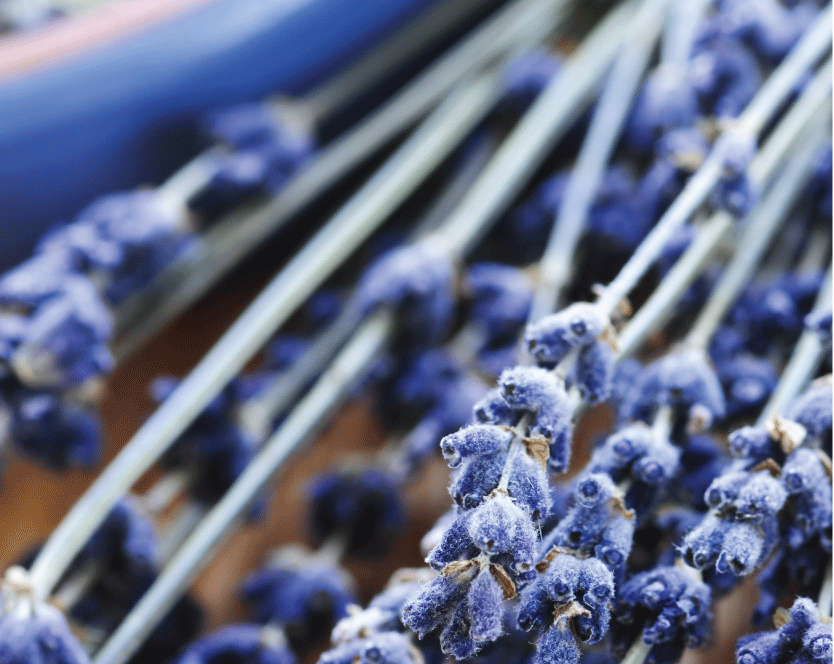With over 40 varieties of lavender, let’s explore the more common varieties.
Lavandula angustifolia is arguably the lavender species that is most used for essential oil production. While lavender essential oil is generally known for its high content of monoterpene, linalool, Lavandula angustifolia is differentiated by the large number of esters it contains, especially linalyl acetate.
Lavandula angustifolia is a great choice in aromatherapy for balancing emotions, decreasing anxiety and stress, soothing respiratory distress, and easing headaches.
It has the presence of several chemical constituents in the essential oil, such as ethyl linalool, fenchone, linalool, α-terpineol, 1,8-cineole, and a higher amount of camphor than its cousins. It has a more medicinal use than fragrant use with high levels of antispasmodic, antifungal, antibacterial, anti-inflammatory, analgesic, repellent, and insecticide properties.
Lavandula latifolia possesses the high linalool content of other lavender essential oils but does not have near the linalyl acetate content of L. angustifolia. This species of lavender is also known to have greater amounts of monoterpene, 1,8 cineole, and camphor terpenoid, giving it powerful antibacterial properties and a more stimulating effect. Lavandula latifolia can also work to soothe headaches and respiratory issues while supporting the circulatory system. It can help ease inflammation and speed the healing of minor wounds and burns while reducing aches and pains in the muscles.
As with any essential oil always use as directed.
English Lavender
The most common variant of lavender is Lavandula Angustifolia or English Lavender. English lavender is much lighter and sweeter than French lavender because it has less camphor, a chemical with a piney, woody scent. English lavender is typically the most appealing variety when it comes to scent and is similar to rosemary. It thrives in cooler, temperate climates, and although it is native to the Mediterranean, the British weather offers the perfect growing conditions. It has a stunning blue-purple bloom and should be planted in full sun, with soil that drains well. English Lavender blooms from mid-spring through to early summer, and the scent will be most potent at this time.Lavandula angustifolia is arguably the lavender species that is most used for essential oil production. While lavender essential oil is generally known for its high content of monoterpene, linalool, Lavandula angustifolia is differentiated by the large number of esters it contains, especially linalyl acetate.
Lavandula angustifolia is a great choice in aromatherapy for balancing emotions, decreasing anxiety and stress, soothing respiratory distress, and easing headaches.
French Lavender
The French Lavender variety is chosen by gardeners more from aesthetics than aroma, the fragrance level is not as strong as in other varietals. The appeal of Lavendula Dentata is the delicately fringed flowers which are vibrant purple and visually stunning. This is also a taller lavender variety that can grow up to a meter tall and wide, making it great for hedging or screenings off an area of the garden. I love it for its more camphor aroma, making it more of a green scent. It lacks some of the more floral aromas of the English variety.It has the presence of several chemical constituents in the essential oil, such as ethyl linalool, fenchone, linalool, α-terpineol, 1,8-cineole, and a higher amount of camphor than its cousins. It has a more medicinal use than fragrant use with high levels of antispasmodic, antifungal, antibacterial, anti-inflammatory, analgesic, repellent, and insecticide properties.
Portuguese Lavender
Sometimes called Spike Lavender, Lavandula Latifolia or Portuguese Lavender has distinctive long stems with pale lilac blooms. This is another edible strain and is well favored for use in drinks, oil, and culinary creations. It has a much more pungent aroma than the English Lavender strain and attracts bees and butterflies making it perfect for nature gardens.Lavandula latifolia possesses the high linalool content of other lavender essential oils but does not have near the linalyl acetate content of L. angustifolia. This species of lavender is also known to have greater amounts of monoterpene, 1,8 cineole, and camphor terpenoid, giving it powerful antibacterial properties and a more stimulating effect. Lavandula latifolia can also work to soothe headaches and respiratory issues while supporting the circulatory system. It can help ease inflammation and speed the healing of minor wounds and burns while reducing aches and pains in the muscles.

